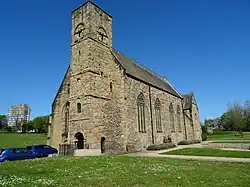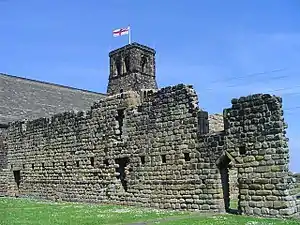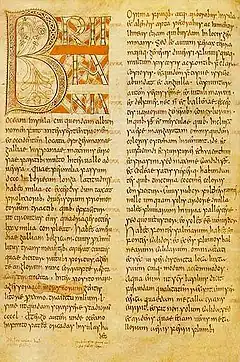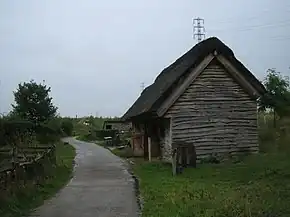 St Peter's Monkwearmouth. View showing the Saxon tower which was built from late 7th to the 10th century.[1] | |
| Monastery information | |
|---|---|
| Full name | The Abbey Church of Saint Peter and Saint Paul, Monkwearmouth–Jarrow |
| Order | Benedictine |
| Established | 674 (Monkwearmouth), 685 (Jarrow) |
| Disestablished | 1536 |
| Dedicated to | SS Peter and Paul |
| Controlled churches | St Peter's Church, Monkwearmouth St Paul's Church, Jarrow |
| People | |
| Founder(s) | Benedict Biscop |
| Important associated figures | Ceolfrith, Bede |
| Architecture | |
| Status | abbey |
| Functional status | parish church of Jarrow still used |
| Heritage designation | two scheduled monuments, three Grade I listed buildings |
| Designated date | 1949 (Jarrow) 1950 (Monkwearmouth) |
| Style | Anglo-Saxon, Gothic, Gothic Revival |
| Completion date | 685 |
The Abbey Church of Saint Peter and Saint Paul, Monkwearmouth–Jarrow, known simply as Monkwearmouth–Jarrow Abbey (Latin: Monasterii Wirimutham-Gyruum), was a Benedictine double monastery in the Kingdom of Northumbria, England.
Its first house was St Peter's, Monkwearmouth, on the River Wear, founded in AD 674–5. It became a double house with the foundation of St Paul's, Jarrow, on the River Tyne in 684–5. Both Monkwearmouth (in modern-day Sunderland) and Jarrow are now in the metropolitan county of Tyne and Wear. The abbey became a centre of learning, producing one of the greatest Anglo-Saxon scholars, Bede.
Both houses were sacked by Viking raiders and in the 9th century the abbey was abandoned. After the Norman Conquest of England in the 11th century there was a brief attempt to revive it. Early in the 14th century the two houses were refounded as cells of Durham Priory. In 1536 they were surrendered to the Crown and dissolved.
Since the dissolution the two abbey churches have survived as the parish churches of Monkwearmouth and Jarrow. The two sets of conventual buildings fell into ruin. At Jarrow substantial ruins survive next to St Paul's church.
The site of each house is a scheduled monument.[2][3] On the Monkwearmouth site St Peter's church is a Grade I listed building.[4] On the Jarrow site both St Paul's church and the monastery ruins are Grade I listed buildings.[5][6] In 2011 the United Kingdom nominated the entire Monkwearmouth–Jarrow Abbey site for UNESCO to grant designate as a World Heritage Site.[7]
Anglo-Saxon period
Foundation
Benedict Biscop founded St Peter's monastery at Monkwearmouth in 674 on land given by King Ecgfrith of Northumbria.[8] He sought to build a model monastery for England, sharing his knowledge of the experience of the Roman traditions in an area previously more influenced by Celtic Christianity stemming from missionaries of Melrose and Iona. A papal letter in 678 exempted the monastery from external control.

In 682 the king was so pleased at the success of St Peter's that he gave Benedict land in Jarrow, where he urged him to build a second monastery[9] This was established in 685 as St Paul's. Benedict appointed Ceolfrith as its superior, who took with him to Jarrow monks from Monkwearmouth, including the young Bede.
The two monasteries were some of the first stone buildings to be built in an English kingdom. England had no masons, so Benedict brought masons from Francia. Benedict wanted glass windows, which were also then unusual in England, so he brought glassmakers also from Francia.[10] The glassmakers had a workshop at Monkwearmouth, on the River Wear near the monastery.[11]
Benedict was well travelled in mainland Europe, and brought books and other materials from Rome[10] and Lérins Abbey.[12] He also persuaded John, arch-cantor of St Peter's Basilica in Rome, to come to teach plainsong at the abbey.[10][13]
The double abbey is often referred to simply as "Jarrow", despite its two houses being 7 miles (11 km) apart. Benedict himself was the first abbot, and the monastery flourished under him and his successors Eosterwine, Ceolfrith, and others, for 200 years. Benedict, on leaving England for Rome in 686, established Ceolfrith as Abbot in Jarrow and Eosterwine at Monkwearmouth;[14] but before his death he stipulated that the two sites should function as "one monastery in two places".
Ceolfrith

As abbot, Ceolfrith continued Benedict's work of establishing the monastery as a centre of learning, scholarship, and especially book production. During this time a distinctive house style of half-uncial script emerged. When he died in AD 716, Monkwearmouth and Jarrow had between them 600 monks.[15]
Ceolfrith's major project was to produce three great "pandect" Bibles (i.e. manuscripts containing the entire text of the Bible), intended to furnish the churches of St Peter's and St Paul's, with the third copy as a gift to the Pope. Of the two copies kept at the abbey, one has been entirely lost, and only fragments survive of the other. The copy meant for the Pope survives as the Codex Amiatinus in Florence and is the oldest surviving Vulgate Bible in the World. Ceolfrith himself was taking it to Rome when he died in 716. His companions continued to Rome and presented it to Pope Gregory II, who by return sent his thanks to Ceolfirth's successor, Abbot Hwaetberht.[16]
Bede

The library Benedict had created on his travels to Rome and then given to the monastery made it the cradle not only of English art but of English literature. Bede was educated under Ceolfrith's patronage and lived, wrote, and died as a monk at Jarrow. By his death Bede had established himself as England's leading scriptural and historical authority.[17]
After his death Bede had a vital influence on the fortunes of the monastery. His writings, most importantly his Ecclesiastical History of the English People, became so popular in the 8th century that they not only assured the reputation of the houses, but influenced the development of Monkwearmouth-Jarrow's distinctive insular minuscule script, developed to increase the speed of book production.[18]
Viking raids
In the 790s Vikings started to raid England. Their first target was Lindisfarne Priory in 793, followed by Monkwearmouth-Jarrow in 794. Danes destroyed the abbey about 860, and it seems to have been finally abandoned in the late 9th century.[19]
Later history
Norman period
In the early 1070s Aldwin, prior of Winchcombe Abbey in Gloucestershire, was inspired by Bede's Historia to tour the sites of the Northumbrian Saxon saints, including Jarrow where he held masses in the Saxon ruins. He and 23 brothers from Evesham Abbey in Worcestershire began to build a new monastery, but its southern and western ranges were still incomplete when they were recalled to Durham Cathedral Priory in 1083.
According to English historian and antiquarian Robert Surtees, William of Malmesbury's statement that Wearmouth and Jarrow were raided by the Scottish king, Malcolm III, is doubtful due to discrepancies in time and place. Surtees pointed to the writings of Symeon of Durham, who was a near contemporary to Malcolm, noting that Symeon said nothing of such a raid and directly asserted that during the period from the Danish invasions to the revival of the monastery by Aldwin, “the site of the convent of Wearmouth lay waste and desolate two hundred and eight years.”[20]
It has been said[21] that "monks of Jarrow had copied out the Himriyan alphabet manuscript" from Hadramouth ( Huraidah region) in Yemen. This is the reflection of human connections in old time between East and West.
Refoundation
Both Monkwearmouth and Jarrow were re-established early in the 14th century, each as a cell of Durham Abbey, occupied by one or two monks under a magister or Master.[14]
Dissolution and aftermath
Under King Henry VIII Parliament passed the Suppression of Religious Houses Act 1535, and in 1536 Monkwearmouth and Jarrow were dissolved. In 1545 the Crown granted all the house and seite of the late cell of Monkwearmouth, valued at about £26 yearly, to Thomas Whitehead, a relative of Prior Hugh Whitehead of Durham, who resigned that monastery in 1540 and became the first Dean of Durham. Monkwearmouth passed afterwards to the Widdrington family, then to that of Fenwick.[22]
The remains of the monastic buildings at Monkwearmouth were incorporated into a private mansion built in the reign of King James I. This burned down in 1790, and no trace of the monastery survives above ground. The parish registers, with the exception of some late entries, were destroyed in the fire.
Today
The present St Peter's Church, Monkwearmouth (54°54′47″N 1°22′30″W / 54.9131°N 1.3749°W), on the north bank of the River Wear, includes the remains of the ancient priory church and is one of the oldest churches in Britain. Its tower was built in phases from the 7th to 10th centuries. The church is now one of three churches in the Parish of Monkwearmouth. It is next to the St Peter's Campus of the University of Sunderland and the National Glass Centre.
The site was excavated by Rosemary Cramp from 1963 to 1978, with a final excavation in 1984.[23] Cramp's excavations revealed early Anglo-Saxon buildings, as well 7th- and 8th-century glass remains.[24][23]
Ruins of the Jarrow house survive next to the former abbey church, which is now the parish church of St Paul (54°58′49″N 1°28′20″W / 54.9804°N 1.4722°W). The Saxon-Norman nave collapsed and was replaced with a Victorian one, but the Saxon chancel survives, with the oldest stained glass window in the world, made from excavated fragments dating from about AD 600.[25] Inside the church, cemented into the wall of the tower, is the original stone slab recording the dedication of the church on 23 April 685. Other than the chancel of St Paul's church, none of the 7th-century monastery survives above ground, but its layout is marked out with stone slabs.
A World Heritage status bid was launched in 2012, but subsequently withdrawn.[26] In the initial bid, the importance of the site was described providing "evidence of the arrival in Britain and development in Europe in the seventh century of ordered, communal monasticism, and the revival of the Roman style of architecture and is an early and formative example of the cloister layout which became standard in Europe north of the Alps during the next millennium and was later transferred to other parts of the world."[27]
Jarrow Hall – Anglo-Saxon Farm, Village and Bede Museum

In Jarrow today near the remains of the monastery is Jarrow Hall, an 11-acre (4.5 ha) site containing a museum of the life and times of Bede and Anglo-Saxon culture, including a working replica Anglo-Saxon farm with replicas of three timber buildings from Northumbria based on archaeological evidence.
The farm demonstrates Anglo-Saxon crop and animal husbandry, with animals bred to simulate breeds farmed in Anglo-Saxon England. There are also interactive museum displays, with a permanent "Age of Bede" exhibition and a collection of Anglo-Saxon to post-medieval objects (many of them excavated from the monastic site of St Paul's, Jarrow), the historic and listed Jarrow Hall House which gives the site its name, and a herb garden.
Burials
Manuscripts written in the Abbey
- Codex Amiatinus, circa 700–710
- St Cuthbert Gospel, circa 710
- Saint Petersburg Bede, between 731 and 746
- Moore Bede?, circa 735
See also the Novem Codices and Codex Grandior, formerly part of the Library, though written in Italy.
See also
- Abbot of Monkwearmouth–Jarrow
- List of English abbeys, priories and friaries serving as parish churches
- Roots of Knowledge, a stained glass installation at Utah Valley University that has a replica of part of the oldest window in the Abbey[28][29]
References
- ↑ Pevsner & Williamson 1983, pp. 465–466.
- ↑ Historic England. "Monkwearmouth Anglo-Saxon monastery and medieval priory (1017222)". National Heritage List for England. Retrieved 12 April 2018.
- ↑ Historic England. "St Paul's Monastery, Jarrow (1002978)". National Heritage List for England. Retrieved 12 April 2018.
- ↑ Historic England. "Church of St Peter (Grade I) (1217958)". National Heritage List for England. Retrieved 12 April 2018.
- ↑ Historic England. "Church of St Paul (Grade I) (1355091)". National Heritage List for England. Retrieved 12 April 2018.
- ↑ Historic England. "St Paul's Monastery, Jarrow (Grade I) (1002978)". National Heritage List for England. Retrieved 12 April 2018.
- ↑ Wearmouth-Jarrow candidate World Heritage Site website
- ↑ "History", St. Peters, Wearmouth-Jarrow
- ↑ Stephens, William (1885). . Dictionary of National Biography. Vol. 04. pp. 214–216.
- 1 2 3 Blair 1977, p. 139.
- ↑ "Monkwearmouth Station Museum". Visually Impaired Person Awareness. Retrieved 16 November 2022.
- ↑ Blair 1977, p. 313.
- ↑ Blair 1977, p. 312.
- 1 2 Page 1907, pp. 79–85.
- ↑ Blair 1977, p. 148.
- ↑ "The first voyage of Codex Amiatinus – Medieval manuscripts blog". blogs.bl.uk. Retrieved 9 May 2019.
- ↑ Boodts, Shari (9 October 2018). "Augustine among the Angels: The Venerable Bede's Impressive Resume". Medievalists.net. Retrieved 16 November 2022.
- ↑ "Monkwearmouth Station Museum".
- ↑ "Ruins of Jarrow Monastery, Jarrow, Tyne and Wear | Educational Images | Historic England".
- ↑ Surtees, Robert. "The History and Antiquities of the County Palatine of Durham, Vol. 2, Chester Ward". British History Online. Retrieved 16 November 2022.
- ↑ Stark, Freya (1936). The Southern Gates of Arabia: A Journey in the Hadramaut. London: John Murray. p. 49.
- ↑ "Wearmouth Abbey". Catholic Encyclopedia. Retrieved 16 November 2022.
- 1 2 Cramp, Rosemary (Spring 2019). "Rosemary Cramp: On celebrating the stone sculpture of the Anglo-Saxons" (PDF). British Academy Review: 26–33.
- ↑ "Digging detective". The Northern Echo. Retrieved 9 May 2019.
- ↑ "Jarrow Hall (UK) | EXARC".
- ↑ "World heritage Status Bid Information". stpeters-wearmouth.org.uk. Retrieved 9 May 2019.
- ↑ "The Twin Monastery of Wearmouth Jarrow". UNESCO World Heritage Centre. Retrieved 9 May 2019.
- ↑ O'Hear, Natasha (8 December 2016). "History illuminated: The evolution of knowledge told through 60,000 pieces of glass". CNN. Archived from the original on 20 April 2017. Retrieved 19 April 2017.
- ↑ Espinosa, Carmen (25 October 2016). "The Roots of Knowledge at Glaziers' Art Fair". Seen London. Archived from the original on 22 April 2017. Retrieved 21 April 2017.
Bibliography
- Bede (731). Ecclesiastical History of the English People. Jarrow.
- Blair, Peter Hunter (1977) [1956]. An Introduction to Anglo-Saxon England (2nd ed.). Cambridge and London: Cambridge University Press. p. 154. ISBN 0-521-29219-0.
- Cramp, Rosemary (2005). Wearmouth and Jarrow Monastic Sites, Vol. 1. Swindon: English Heritage. ISBN 1-873592-93-0.
- Cramp, Rosemary (2006). Wearmouth and Jarrow Monastic Sites, Vol. 2. Swindon: English Heritage. ISBN 1-873592-94-9.
- Page, William, ed. (1907). "Saxon Houses: including Wearmouth and Jarrow". A History of the County of Durham. Victoria County History. Vol. II. Westminster: Archibald Constable & Co. pp. 79–85.
- Pevsner, Nikolaus; Williamson, Elizabeth (revision) (1983) [1953]. County Durham. The Buildings of England (2nd ed.). Harmondsworth: Penguin Books. pp. 338–341, 465–467. ISBN 0-14-071009-4.
- Bede's World guidebook, 2004
External links
- St. Peter's Wearmouth–Jarrow
- Parish of Monkwearmouth
- St Paul's, Church Bank
- "Wearmouth-Jarrow Monastic Sites". Saints and Stones.
- David Dimbleby. "Age of Conquest". Seven Ages of Britain. 33:38 minutes in. BBC1.
- Jarrow Hall – official website
